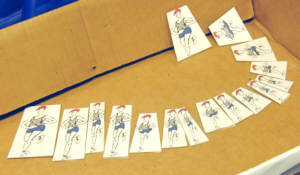
There are 16 athletes here,
all different.

Almost everyone interprets
the problem as,
"How do I line 'em up?"
But a line can't do the job.
The athletes have both weight and height.
That's two different parameters
of "size." A line is one dimensional (even if it curves about.)
The
problem requires two dimensions.

However, if we turn over a tile, we find
a different athlete on the other side.
One one side is an athlete who is a beanpole
or a bit wide in the middle,
on the other side is an athlete who is
wide across the shoulders.

We have a third dimension!
— fitness —
These new athletes also require two dimensions
for themselves
